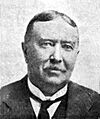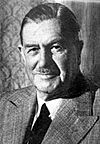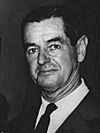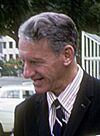Prime Minister of Rhodesia facts for kids
Quick facts for kids Prime Minister of Rhodesia |
|
|---|---|

Flag of the prime minister of Rhodesia (1970–1979)
|
|
| Style | The Right Honourable |
| Member of | Cabinet of Rhodesia (1965–1979) |
| Residence | Independence House, Salisbury (now Harare) |
| Appointer |
|
| Formation | 1 October 1923 |
| First holder | Charles Coghlan |
| Final holder | Ian Smith |
| Abolished | 1 June 1979 |
| Deputy | Deputy Prime Minister of Rhodesia |
The prime minister of Rhodesia was the main leader of the government in Rhodesia. Before 1964, this country was known as Southern Rhodesia. In 1923, Southern Rhodesia became a self-governing colony of the United Kingdom. This meant it could make many of its own laws.
On November 11, 1965, Rhodesia declared its independence from Britain. This was a Unilateral Declaration of Independence (UDI). However, no other countries recognized Rhodesia as an independent state. It remained an unrecognized state until 1979. In December 1979, Britain took temporary control. Then, in April 1980, the country became truly independent as Zimbabwe.
Rhodesia's government system was like the Westminster system. This system is used in countries like Australia and Canada. The prime minister's job was similar to leaders in those countries.
Contents
History of Rhodesia's Government Leaders
How Southern Rhodesia Began
The British self-governing colony of Southern Rhodesia started on October 1, 1923. This land was previously managed by the British South Africa Company. The British government took control of the land. Then, they sold it to the new Southern Rhodesian government for £2 million. From October 1964, Southern Rhodesia was simply called Rhodesia.
The Central African Federation
From 1953 to 1963, Southern Rhodesia joined with Northern Rhodesia and Nyasaland. These are now known as Zambia, Zimbabwe, and Malawi. They formed the Federation of Rhodesia and Nyasaland, also called the Central African Federation.
Godfrey Huggins was the first Federal Prime Minister from 1953 to 1956. After him, Roy Welensky held the position until the Federation ended on December 31, 1963. When Northern Rhodesia became independent as Zambia in 1964, Southern Rhodesia started calling itself "Rhodesia."
Rhodesia's Unilateral Declaration of Independence
In 1965, Prime Minister Ian Smith's government declared independence from Britain. This was the Unilateral Declaration of Independence (UDI). When Rhodesia became a republic in 1970, Ian Smith remained prime minister.
After a long conflict, the country was renamed Zimbabwe Rhodesia in 1979. This happened under the Internal Settlement. Abel Muzorewa became its first black prime minister. However, other countries did not recognize these changes.
Return to British Rule and Independence
Under the Lancaster House Agreement, Rhodesia agreed to return to being a British colony in 1979. This step helped the country move towards majority rule. In 1980, the independent state of Zimbabwe was created.
The job of Prime Minister of Zimbabwe was removed in 1987. At that time, Robert Mugabe became the executive president. However, in 2009, the prime minister role was brought back. This happened through political talks. Morgan Tsvangirai then became the first prime minister of Zimbabwe in over 21 years.
List of Rhodesia's Prime Ministers
- Political Parties
Rhodesia Party
Reform Party
United Party / United Rhodesia Party / United Federal Party
Rhodesian Front
| No. | Portrait | Name (Birth–Death) Constituency |
Time in Office | Elected (Parliament) |
Political party | ||
|---|---|---|---|---|---|---|---|
| Started | Ended | Length of time | |||||
| 1 |  |
Charles Coghlan (1863–1927) MP for Bulawayo North |
1 October 1923 | 28 August 1927 | 3 years, 331 days | 1924 (1st) | Rhodesia Party |
| He was the first leader after Southern Rhodesia gained self-government. He helped the government buy the country from the British South Africa Company. He did not want Southern Rhodesia to join with Northern Rhodesia or South Africa. He died while in office. | |||||||
| 2 |  |
Howard Moffat (1869–1951) MP for Gwanda |
2 September 1927 | 5 July 1933 | 5 years, 306 days | — (1st) 1928 (2nd) |
Rhodesia Party |
| He was seen as a traditional leader. He helped the government buy the remaining mineral rights from the British South Africa Company. His government passed the 1930 Land Apportionment Act. This law set rules for land ownership and is linked to later land disputes in Zimbabwe. He resigned from his position. | |||||||
| 3 |  |
George Mitchell (1867–1937) MP for Gwanda |
5 July 1933 | 12 September 1933 | 69 days | — (2nd) | Rhodesia Party |
| He changed the title from "Premier" to "Prime Minister." He served the shortest time as Prime Minister of Southern Rhodesia. His party lost the 1933 election. | |||||||
 |
Godfrey Huggins (1883–1971) MP for Salisbury North |
12 September 1933 | 7 September 1953 | 19 years, 360 days | 1933 (3rd) 1934 (4th) 1939 (5th) 1946 (6th) 1948 (7th) |
Reform Party (until 1934) United Party (from 1934) |
|
| 4 | |||||||
| He was the longest-serving Prime Minister of Southern Rhodesia. He formed the United Party by joining with the Rhodesia Party. He was prime minister during World War II. He supported joining Southern Rhodesia with other British colonies to form an independent state. This state would remain part of the British Empire but keep white minority rule. His efforts led to the creation of the Federation of Rhodesia and Nyasaland in 1953. He resigned to become the first Prime Minister of the Federation. | |||||||
| 5 |  |
Garfield Todd (1908–2002) MP for Shabani |
7 September 1953 | 17 February 1958 | 4 years, 163 days | — (7th) 1954 (8th) |
United Rhodesia Party |
| He introduced small changes to improve education for the Black majority. He also made it easier for Black people to buy and sell alcohol. He supported allowing trade unions for all races. He tried to increase the number of Black voters, but this idea was rejected. Many white people thought his changes were too extreme, and he was forced to resign. | |||||||
| 6 |  |
Edgar Whitehead (1905–1971) MP for Salisbury North |
17 February 1958 | 17 December 1962 | 4 years, 303 days | — (8th) 1958 (9th) |
United Federal Party |
| During his time, the economy grew quickly. He also saw the start of the end of the Federation of Rhodesia and Nyasaland. He helped create the 1961 constitution, which gave Black people more representation in parliament. He tried to reduce racial discrimination and register more Black voters. However, there was also civil unrest and stricter security. His policies worried white people, and Black people felt their progress was too slow. He lost the 1962 election. | |||||||
| 7 |  |
Winston Field (1904–1969) MP for Marandellas |
17 December 1962 | 13 April 1964 | 1 year, 118 days | 1962 (10th) | Rhodesian Front |
| He oversaw the end of the Federation of Rhodesia and Nyasaland. His government gained most of the Federation's military and other assets for Southern Rhodesia. He was forced to resign because he could not get independence from the United Kingdom. | |||||||
| 8 |  |
Ian Smith (1919–2007) MP for Umzingwane |
13 April 1964 | 1 June 1979 | 15 years, 49 days | — (10th) 1965 (11th) 1970 (12th) 1974 (13th) 1977 (14th) |
Rhodesian Front |
| His government issued the Unilateral Declaration of Independence (UDI) from the United Kingdom in 1965. This led to international criticism and economic sanctions from the United Nations. Rhodesia had some support from South Africa and Portugal. He declared Rhodesia a republic in 1970. The Rhodesian Bush War started in 1964 and grew into a large conflict after 1972. Rhodesia became more isolated when Mozambique became independent in 1975 and South Africa reduced its support. Under pressure, Smith agreed to a form of majority rule in 1978. He signed the Internal Settlement with Abel Muzorewa, a moderate black nationalist leader. This agreement was not recognized by other countries or by major black nationalist groups. As part of this agreement, elections were held in 1979. Rhodesia was then renamed Zimbabwe Rhodesia, and Muzorewa became the new Prime Minister. | |||||||
See also
- Governor of Southern Rhodesia
- President of Rhodesia
- Prime Minister of Zimbabwe Rhodesia
- Prime Minister of Zimbabwe

